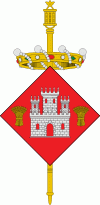Palafrugell
 |
 |
The area's summer climate and beaches have been exploited for tourism. In additional to international tourism, Palafrugell serves as a summer holiday town for residents of cities such as Barcelona and Girona.
This medieval town was once fortified but is no longer. Many narrow streets emanate from Plaça Nova -a large square with bars, restaurants and boutiques. The local government (Ajuntament) sponsors activities such as concerts and dances including the traditional Sardana. St. Martí's church was built in the late 11th century and is close to Plaça Nova.
There is a new bus station belonging to Grup SARBUS whose local division is known as Sarfa. The station has a regular bus service, servicing the Costa Brava region (including Llafranc, Calella de Palafrugell, and Tamariu) as well as Barcelona.
Palafrugell was reputed for its cork manufacturing in the 18th and 19th centuries. The largest factory was owned by the American company Armstrong and employed hundreds of locals. Its closing in the 1970s led to severe unemployment. The factory's tower still stands, and there is now a small museum commemorating the cork industry just below it.
Palafrugell was served by the gauge Palamós–Girona–Banyoles railway, which reached a junction with the Barcelona–Cerbère railway at Flaçà by 1887 and was extended to Girona by 1921. Service on the line continued until 1956.
Besides the town of Palafrugell itself, the municipality includes the following populated places:
* El Bruguerol
* Calella de Palafrugell
* Ermedàs (Palafrugell)
Map - Palafrugell
Map
Country - Spain
 |
 |
| Flag of Spain | |
Anatomically modern humans first arrived in the Iberian Peninsula around 42,000 years ago. The ancient Iberian and Celtic tribes, along with other pre-Roman peoples, dwelled the territory maintaining contacts with foreign Mediterranean cultures. The Roman conquest and colonization of the peninsula (Hispania) ensued, bringing the Romanization of the population. Receding of Western Roman imperial authority ushered in the migration of different non-Roman peoples from Central and Northern Europe with the Visigoths as the dominant power in the peninsula by the fifth century. In the early eighth century, most of the peninsula was conquered by the Umayyad Caliphate, and during early Islamic rule, Al-Andalus became a dominant peninsular power centered in Córdoba. Several Christian kingdoms emerged in Northern Iberia, chief among them León, Castile, Aragon, Portugal, and Navarre made an intermittent southward military expansion, known as Reconquista, repelling the Islamic rule in Iberia, which culminated with the Christian seizure of the Emirate of Granada in 1492. Jews and Muslims were forced to choose between conversion to Catholicism or expulsion, and eventually the converts were expelled through different royal decrees.
Currency / Language
| ISO | Currency | Symbol | Significant figures |
|---|---|---|---|
| EUR | Euro | € | 2 |
| ISO | Language |
|---|---|
| EU | Basque language |
| CA | Catalan language |
| GL | Galician language |
| OC | Occitan language |
| ES | Spanish language |















